Click on an image below to see a larger version. Right click on an image and choose “Save image as…” to use it in your digital interactive.
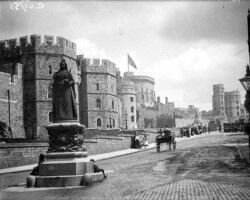
Windsor Castle, Windsor, Windsor and Maidenhead
View from Peascod Street with a statue of Queen Victoria in the foreground. Windsor is England's largest castle and a royal palace. The castle dates back to William the Conqueror but the first stone buildings were erected by Henry II between 1165 and 1179
Photograph taken 1888 © Reproduced by permission of Historic England Archive ref: CC41/00056

Castle Rising, Norfolk
The mid-12th-century keep at Castle Rising is set within a massive defensive earthwork. The Castle was established in circa 1138 on the site of the Saxon village by William de Albini II, later Earl of Sussex. This property is now in the care of English Heritage (2010) but owned and managed by Lord howard of Rising.
Photograph taken September 1997 © Crown copyright. Historic England Archive ref: nmr 15808/21

Kenilworth Castle, Kenilworth, Warwickshire
The first castle was built here soon after the Norman Conquest, and the impressive keep (seen here) survives. Simon de Montfort held the castle in the mid 13th century, while in the 17th century it was the home of Robert Dudley, Earl of Essex and favourite of Queen Elizabeth. Many of the buildings date from this period. This property is now in the care of English Heritage (2010).
Photograph taken 1945 - 1980 © Historic England Archive ref: AA98/04938
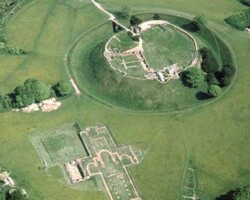
Old Sarum, Salisbury, Wiltshire
An aerial view of Old Sarum showing the motte and bailey castle and the remains of the medi bishop's palace. The bishop's seat was transferred to nearby Salisbury in 1219 which gradually led to the decline of the Old Sarum site. This site is now in the care of English Heritage (2010).
Photograph taken May 1988 © Crown copyright. Historic England Archive ref: nmr 4117/14
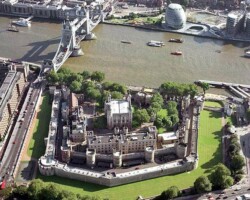
Tower of London, Tower Bridge and the Greater London Authority offices, London
Although the White Tower, built in 1078, is Norman other parts of The Tower of London were added at various later dates. It was the seat of government for the whole country during the medi period.
Photograph taken August 2002 © Copyright Historic England Archive ref: NMR 21766/19

Tower of London, Stepney, London
The White Tower is the keep at the heart of the Tower. It was built around 1078 -1100 for William I and William II. This is the earliest known image.
Photograph taken 1945 - 1980 © Historic England Archive ref: AA98/06478

Oxford Castle, Oxford, Oxfordshire
This 17th century oblique view of the castle site shows the Norman motte or mound built in 1091 by forced Saxon labour. A wooden keep stood on this. The castle was used by the Normans to keep control of the town. Also visible are the remains of the Shire Hall, as well as St George's Tower and Castle Mill beyond.
Photograph taken 17th Century © Reproduced by permission of Historic England Archive ref: CC51/00370

Stokesay Castle, Craven Arms, Shropshire
Stokesay Castle is the finest and best-preserved 13th-century fortified manor house in England. It was fortified by Lawrence de Ludlow, a wool merchant, who received his 'License to Crenellate' from Edward 1 in 1291. This property is now in the care of English Heritage (2010).
Photograph taken 1930 © Copyright Crown copyright.NMR ref: bb67/06973
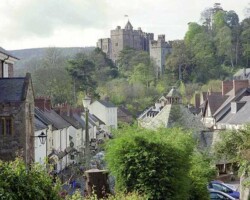
Dunster Castle, Dunster, Somerset
A view of part of Dunster Castle from the town. There is now no trace of the original Norman castle at Dunster. The present castle dates mainly from the 15th century when the Luttrell family became the owners. It has been reconstructed several times, most recently in the 19th century and was given to the National Trust in 1976.
Photograph taken April 1999 © Copyright Crown copyright.NMR ref: aa99/06306
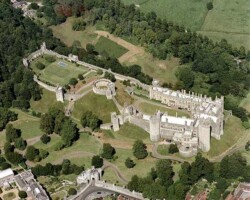
Arundel Castle, Arun, West Sussex
An aerial view of the castle which is the home of the Dukes of Norfolk. At its centre is a Norman earthen motte. The upper and lower baileys were constructed in the 12th century. The lower bailey contains the main living quarters which were created in 1890-1903.
Photograph taken August 1998 © Crown copyright. Historic England Archive ref: nmr 18125/06
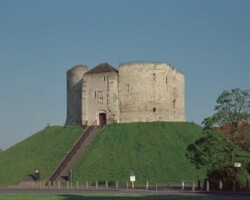
Clifford's Tower (York Castle), York
William the Conqueror built the castle for his northern campaign of terror in 1069. The stone keep was built in 1245-72. At various points in its history, Clifford’s Tower became a royal mint, functioned as a prison, gruesomely displayed the bodies of leaders of uprisings, and was even a court. This site is now in the care of English Heritage (2010).
Photograph taken 12 May 2001 © Historic England Archive/Mr Martin Roberts ref: 462999
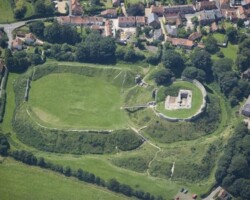
Castle Acre Castle, Castle Acre, Norfolk
The remains of Castle Acre Castle are located in the southern part of the modern village of Castle Acre. They include a roughly circular inner bailey, an adjoining outer bailey and a triangular barbican (tower).
Photograph taken 01 August 2001 © Damian Grady. Source Historic England Archive ref: 221880

Aerial View of Pendennis Castle, Falmouth, Cornwall
Pendennis was constructed between 1540 and 1545 by order of Henry VIII as part of a the Cornish end of a chain of coastal castles designed to defend England from a possible French or Spanish invasion. The original Tudor fort is now part of a much larger castle. This site is now in the care of English Heritage (2010).
Photograph taken unavailable © Crown copyright. Historic England Archive ref: nmr 10700/56a

Restormel Castle, Lostwithiel, Cornwall
Built on a spur overlooking the River Fowey with an unusual circular keep circa 1100, Restormel Castle is one of the oldest and best preserved Norman motte and bailey castles in Cornwall. Heavily defended by a 17 metre moat and artificially steepened foundation, the castle was rebuilt in the 13th century by Edmund, Earl of Cornwall, for use as a residence. The castle's condition is partly a result of its use a garrison in the Civil War. This site is now in the care of English Heritage (2010).
Photograph taken 1951-1963 © Skyscan Balloon Photography. Source Historic England Archive Photo Library ref: K930337
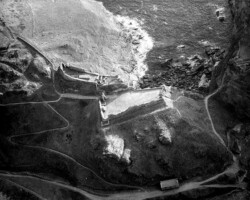
Tintagel Castle, Cornwall
Richard of Cornwall built Tintagel castle in the 13th century. This dramatic defensive position had been occupied long before by the Romans. It is also thought to have been a trading settlement of Celtic kings during the 5th and 6th centuries. This site is now in the care of English Heritage (2010).
Photograph taken July 1959 © Copyright Crown copyright.NMR ref: HAW 9400/49
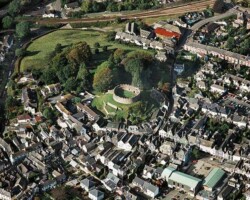
Totnes Castle, Totnes, Devon
Totnes Castle was first built as a motte and bailey castle by Judhael of Brittany shortly after the Norman Conquest in 1066 AD. It is situated on high ground in close proximity to the River Dart and overlooks Totnes town, which dates back to Saxon times.
Photograph taken October 2005 © Copyright Historic England Archive ref: nmr 24090/19
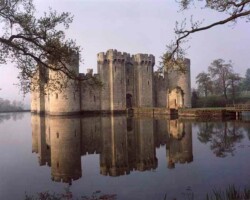
Bodiam Castle, East Sussex
A view of Bodiam Castle looking across the moat. The castle was built in the late 14th century after Sir Edward Dalyngridge was granted permission to build on the manor against possible French invasion in 1385.It was built to look like a strong medi castle with round towers but was, in fact, designed more for show than strength.
Photograph taken 1989 © Copyright Crown copyright.NMR ref: bb92/17783
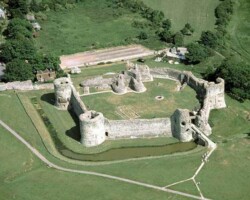
Pevensey Castle, Pevensey, East Sussex
A Roman fort originally stood on this site. After the Norman Conquest it was given to William the Conqueror's half-brother. By the end of the 11th century he had constructed a full scale Norman castle using the Roman walls. It lay uninhabited from the 16th century. This property is now in the care of English Heritage (2010).
Photograph taken June 1989 © Crown copyright. Historic England Archive ref: nmr 4511/02
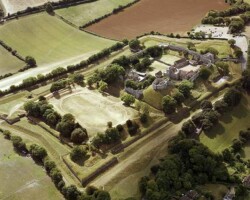
Carisbrooke Castle, Carisbrooke, Isle of Wight
Standing on a partly-artificial elevation, Carisbrooke Castle occupies site of an earlier Saxon stronghold which replaced a Roman Castra. As the premier defensive site on the Isle of Wight, Carisbrooke was re-fortified by Elizabeth 1st against the perceived threat of the Spanish Armada. The north gate of the outer wall recalls this, and is inscribed ER 1598. This property is now in the care of English Heritage (2010).
Photograph taken September 2003 © Copyright Historic England Archive ref: nmr 23246/19
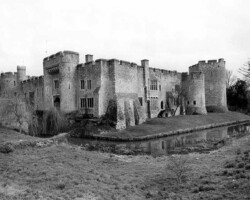
Allington Castle, Maidstone, Kent
Allington Castle surrounded by a moat. It was originally a manor house until it was turned into an embattled castle by Stephen de Penchester in 1281. The castle lay in a ruinous state until it was restored by Sir Martin Conway.
Photograph taken February 1991 © Copyright Crown copyright.NMR ref: bb91/14657
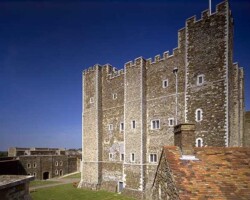
The Keep, Dover Castle, Dover, Kent
The strategic importance of Dover has long been recognised. The great Keep, built in the 1180s by King Henry II to provide both security and accomodation, was the strongpoint of the medi Castle. It remained a military site until the end of World War II. This property is now in the care of English Heritage (2010).
Photograph taken May 1997 © Copyright Historic England Archive Photo Library ref: k970499
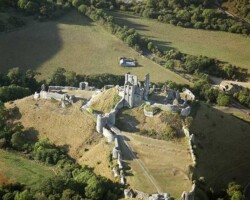
Corfe Castle, Dorset
Corfe Castle was built after the Norman Conquest in the 11th century. Improved by later Monarchs including Henry VIII, who added additional walls, towers and gatehouses, the Castle remained in Royal possession until sold by Elizabeth 1st in the 16th century. Its ruinous condition is largely the result of the Civil War when it was besieged and partially demolished by order of Parliament in 1646. The Castle is also believed to be the inspiration for Enid Blyton's Kirrin Castle.
Photograph taken September 2003 © Copyright Historic England Archive ref: nmr 23295/24

